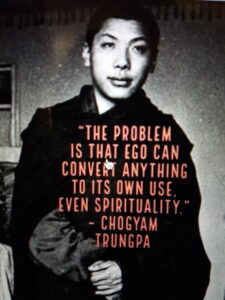Méditer
A recurring theme in Trungpa Rinpoche’s teachings is “non-distraction” which is related to “mindfulness of effort”, “awareness as non-distraction”
“The next foundation of mindfulness is mindfulness of effort. The idea of effort is apparently problematical. Effort would seem to be at odds with the sense of being that arises from mindfulness of body. Also, pushing of any kind does not have an obvious place in the touch-and-go technique of the mindfulness of life.
In either case, deliberate, heavy-handed effort would seem to endanger the open precision of the process of mindfulness. Still we cannot expect proper mindfulness to develop without some kind of exertion on our part. Effort is necessary. But the Buddhist notion of right effort is quite different from conventional definitions of effort.
The traditional Buddhist analogy for right effort is the walk of an elephant or tortoise. The elephant moves along surely, unstoppably, with great dignity. Like the worm, it is not excitable, but unlike the worm, it has a panoramic view of the ground it is treading on. Though it is serious and slow, because of the elephant’s ability to survey the ground there is a sense of playfulness and intelligence in its movement.
In the case of meditation, trying to develop an inspiration that is based on wanting to forget one’s pain and on trying to make one’s practice thrive on a sense of continual accomplishment is quite immature. On the other hand, too much solemnity and dutifulness creates a lifeless and narrow outlook and a stale psychological environment. The style of right effort, as taught by the Buddha, is serious but not too serious. It takes advantage of the natural flow of instinct to bring the wandering mind constantly back to the mindfulness of breathing.
The crucial point in the bringing-back process is that it is not necessary to go through deliberate stages. It is not a question of forcing the mind back to some particular object, but of bringing it back down from the dream world into reality. We are breathing, we are sitting. That is what we are doing, and we should be doing it completely, fully, wholeheartedly.
There is a kind of technique, or trick, here that is extremely effective and useful, not only for sitting meditation, but also in daily life, or meditation-in-action. The way of coming back is through what we might call the abstract watcher. This watcher is just simple self-consciousness, without aim or goal.
Mindfulness of effort cannot be deliberately manufactured: on the other hand, it is not enough just to hope that a flash will come to us and we will be reminded. There must be a background of discipline which sets the tone of the sitting practice.
When we encounter anything, the first flash that takes place is the bare sense of duality, of separateness. On that basis, we begin to evaluate, pick and choose, make decisions, execute our will. The abstract watcher is just the basic sense of separateness—the plain cognition of being there before any of the rest develops.
Instead of condemning this self-consciousness as dualistic, we take advantage of this tendency in our psychological system and use it as the basis of the mindfulness of effort. The experience is just a sudden flash of the watcher’s being there. At that point we don’t think, “I must get back to the breath” or “I must try and get away from these thoughts.” We don’t have to entertain a deliberate and logical movement of mind that repeats to itself the purpose of sitting practice. There is just suddenly a general sense that something is happening here and now, and we are brought back. Abruptly, immediately, without a name, without the application of any kind of concept, we have a quick glimpse of changing the tone. That is the core of the mindfulness of effort practice.
One of the reasons that ordinary effort becomes so dreary and stagnant is that our intention always develops a verbalization. Any kind of sense of duty we might have is always verbalized, though the speed of conceptual mind is so great that we may not even notice the verbalization. Still, the contents of the verbalization are clearly felt. This verbalization pins the effort to a fixed frame of reference, which makes it extremely tiresome.
In contrast, the abstract effort we are talking about flashes in a fraction of a second, without any name or any idea with it. It is just a jerk, a sudden change of course which does not define its destination. The rest of the effort is just like an elephant’s walk—going slowly, step by step, observing the situation around us.
You could call this abstract self-consciousness leap if you like, or jerk, or sudden reminder; or you could call it amazement. Sometimes it could also be felt as panic, unconditioned panic, because of the change of course—something comes to us and changes our whole course. If we work with this sudden jerk, and do so with no effort in the effort, then effort becomes self-existing. It stands on its own two feet, so to speak, rather than needing another effort to trigger it off.
This kind of effort is extremely important. The sudden flash is a key to all Buddhist meditation, from the level of basic mindfulness to the highest levels of tantra. Such mindfulness of effort could definitely be considered the most important aspect of mindfulness practice. Mindfulness of body creates the general setting; it brings meditation into the psychosomatic setup of one’s life. Mindfulness of life makes meditation practice personal and intimate. Mindfulness of effort makes meditation workable: it connects the foundations of mindfulness to the path, to the spiritual journey. It is like the wheel of a chariot, which makes the connection between the chariot and the road, or like the oar of a boat. Mindfulness of effort actualizes the practice; it makes it move, proceed.
But we have a problem here. Mindfulness of effort cannot be deliberately manufactured: on the other hand, it is not enough just to hope that a flash will come to us and we will be reminded. There must be a background of discipline which sets the tone of the sitting practice. Effort is important on this level also; it is the sense of not having the faintest indulgence toward any form of entertainment. We have to give something up. Unless we give up our reservations about taking the practice seriously, it is virtually impossible to have that kind of instantaneous effort dawn on us. So it is extremely important to have respect for the practice, a sense of appreciation, and a willingness to work hard.
Once we do have a sense of commitment to relating with things as they actually are, we have opened the way to the flash that reminds us: that, that, that. “That what?” does not apply any more. Just that, which triggers an entirely new state of consciousness and brings us back automatically to mindfulness of breathing or a general sense of being.
We work hard at not being diverted into entertainment. Still, in some sense, we can enjoy the very boring situation of the practice of sitting meditation. We can actually appreciate not having lavish resources of entertainment available. Because of having already included our boredom and ennui, we have nothing to run away from and we feel completely secure and grounded.
This basic sense of appreciation is another aspect of the background that makes it possible for the spontaneous flash of the reminder to occur more easily. This is said to be like falling in love. When we are in love with someone, because our whole attitude is open toward that person somehow or other we get a sudden flash of that person not as a name or as a concept of what the person looks like; those are afterthoughts. We get an abstract flash of our lover as that. A flash of that comes into our mind first. Then we might ponder on that flash, elaborate on it, enjoy our daydreams about it. But all this happens afterward. The flash is primal. “
From “Lion’s Roar by Chogyam Trungpa Rinpoche”.

